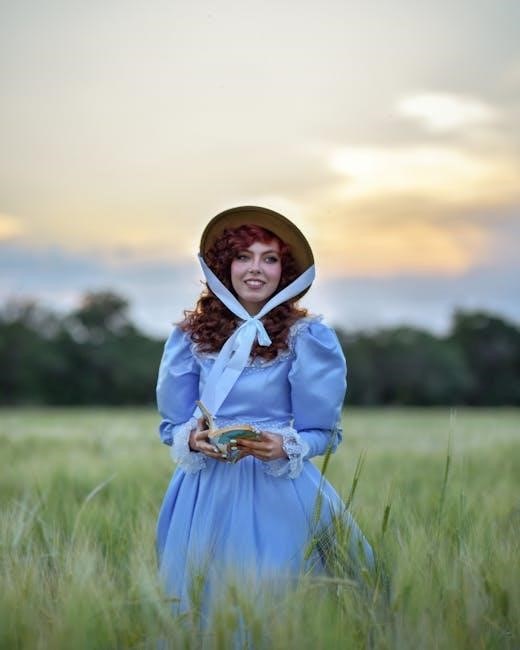Gaston Leroux’s 1910 novel, The Phantom of the Opera, is a Gothic mystery set in the Paris Opera House, exploring themes of obsession, love, and identity through the enigmatic Phantom and his connection to Christine Daaé.

1.1 Overview of the Novel
The Phantom of the Opera, written by Gaston Leroux, is a Gothic mystery novel published in 1910. Set in the Paris Opera House, it follows the haunting tale of the Phantom, a disfigured musical genius obsessed with Christine Daaé, a young soprano. The story intertwines themes of love, obsession, and identity, blending mystery, romance, and the supernatural, making it a timeless classic available in various formats, including PDF.
1.2 Historical Context and Significance
The Phantom of the Opera was first published in 1910, drawing inspiration from real-life events at the Paris Opera House, such as accidents and rumors of a ghostly figure. The novel’s success lies in its blend of Gothic mystery and romantic tragedy, cementing its place in literary history and influencing countless adaptations in theater, film, and music.

Gaston Leroux and His Background
Gaston Leroux was a French author and journalist, best known for The Phantom of the Opera. His background in law and journalism influenced his unique storytelling style.
2.1 Biography of Gaston Leroux
Gaston Leroux, born on May 6, 1868, in Paris, was a French author and journalist. He studied law but transitioned to journalism, where his experiences as a crime reporter influenced his writing. Leroux’s works include detective novels and the renowned The Phantom of the Opera. His background in journalism and fascination with mystery shaped his literary career, blending reality and fiction.
2.2 Leroux’s Literary Style and Influences
Gaston Leroux’s writing blended mystery, romance, and atmospheric settings, influenced by his journalism career. His suspenseful storytelling and vivid descriptions, as seen in The Phantom of the Opera, reflect his fascination with crime and the supernatural. Leroux’s unique style captivated readers, making his works enduring classics in Gothic literature and beyond.
Historical Inspirations for The Phantom of the Opera
Gaston Leroux drew inspiration from real-life events at the Paris Opera House, such as a counterweight crash and a fire, shaping the novel’s eerie atmosphere.

3.1 Real-Life Events at the Paris Opera House
Gaston Leroux drew inspiration from real-life incidents at the Paris Opera House, such as a counterweight crashing through the ceiling and a fire damaging the building. These events, along with the opera’s labyrinthine underground tunnels, influenced the novel’s eerie atmosphere and the Phantom’s haunting presence, blending reality with fiction to create a captivating tale of mystery and terror.
3.2 The Legend of the Opera Ghost
The legend of the Opera Ghost captivated Paris, with tales of a mysterious figure haunting the opera house. Leroux’s novel immortalized this legend, portraying the Phantom as a tragic, enigmatic figure residing in the labyrinthine tunnels beneath the opera. His haunting presence and influence over Christine Daaé became central to the story, blending myth with the grandeur of the Paris Opera House.
Plot Summary of The Phantom of the Opera
The story unfolds in the Paris Opera House, where the mysterious Phantom, a disfigured genius, secretly mentors Christine Daaé, a young soprano, and becomes obsessed with her talent.
4.1 The Mysterious Phantom and His Obsession
The Phantom, a masked and disfigured musical genius, haunts the Paris Opera House, controlling its operations from the shadows. His obsession with Christine Daaé, a talented young soprano, drives the plot, blending love, terror, and tragedy as he seeks to possess her voice and soul, revealing his dark, isolated world beneath the opera.
4.2 Christine Daaé and Her Rise to Fame
Christine Daaé, a young Swedish soprano, rises to fame under the mysterious guidance of the Phantom. Her natural talent and the Phantom’s haunting influence propel her to stardom at the Paris Opera House, but her success is intertwined with eerie events and the Phantom’s obsession, marking her as the center of the opera’s dark intrigue.
4.3 The Tragic Love Triangle
The story centers on a tragic love triangle between Christine Daaé, the Phantom, and Raoul. The Phantom’s unrequited love for Christine drives his obsession, while Christine fears his control. Raoul’s arrival rekindles her past, leading to a devastating conflict. The Phantom’s possessiveness and Christine’s torn emotions culminate in a heartrending tragedy, highlighting the destructive power of love and obsession.

Major Characters in The Phantom of the Opera
The novel revolves around Erik, the enigmatic Phantom; Christine Daaé, a talented soprano; and Raoul, Christine’s childhood sweetheart. Their complex relationships drive the tragic narrative.
5.1 Erik (The Phantom)
Erik, the Phantom, is a mysterious, deformed musical genius who haunts the Paris Opera House. His obsession with Christine Daaé drives his actions, blending love, possessiveness, and tragedy. Despite his terrifying presence, Erik evokes pity due to his isolating deformity and unrequited love, making him one of literature’s most complex and sympathetic villains.
5.2 Christine Daaé
Christine Daaé, a young Swedish soprano, becomes the focal point of the Phantom’s obsession. Her talent flourishes under his guidance, but she is torn between her gratitude to Erik and her love for Raoul. Her journey from innocence to self-discovery highlights her strength and vulnerability, making her a central figure in the tragic narrative of the novel.
5.3 Raoul, the Vicomte de Chagny
Raoul, the Vicomte de Chagny, is Christine’s childhood friend and later suitor. His noble background and romantic ideals contrast with the Phantom’s darkness. Driven by love and courage, Raoul confronts the Phantom to rescue Christine, embodying the hope of redemption in the tragic love triangle that dominates the story. His actions highlight themes of bravery and devotion.
Themes and Motifs in the Novel
The novel explores themes of obsession, unrequited love, beauty versus deformity, isolation, and redemption, intertwined with haunting imagery and moral dilemmas, shaping its enduring legacy.
6.1 Obsession and Unrequited Love
The Phantom’s all-consuming obsession with Christine Daaé drives the novel’s tragic narrative, showcasing the destructive power of unrequited love. His fixation leads to manipulation, fear, and ultimately, heartbreak, as Christine struggles between her admiration for the Phantom and her love for Raoul, creating a poignant exploration of devotion and its darker implications.
6.2 Beauty and Deformity
The novel juxtaposes the Phantom’s physical deformity with his extraordinary musical genius, highlighting the tension between external appearance and inner beauty. Christine’s radiant beauty contrasts with the Phantom’s hideous visage, exploring societal perceptions of attractiveness and the isolation it imposes, while also revealing the profound emotional depth beneath his disfigured form.
6.3 Isolation and Redemption
The Phantom’s deformity isolates him, forcing him into the shadows of the opera house. His obsession with Christine drives a tragic quest for connection, yet his unrequited love ultimately leads to sacrifice. The novel explores redemption through his acceptance of solitude, revealing the depth of his humanity beneath the mask of deformity and terror.

The Phantom of the Opera, published in 1910, is widely available as a free PDF download, offering legal access to Gaston Leroux’s timeless tale of love and mystery.
7.1 Availability of the PDF Version
The Phantom of the Opera book PDF is widely available online, including through platforms like Project Gutenberg and ManyBooks. Its public domain status ensures free access, making it easily downloadable from various digital libraries and eBook stores, such as Google Books and Internet Archive, allowing readers worldwide to enjoy Gaston Leroux’s timeless tale of love, mystery, and obsession.
7.2 Legal and Free Download Options
The Phantom of the Opera book PDF is in the public domain, allowing legal and free downloads from reputable sources like Project Gutenberg and ManyBooks. These platforms offer safe, high-quality versions without copyright restrictions, ensuring readers can access Gaston Leroux’s classic tale effortlessly while complying with legal guidelines.

Adaptations and Popularity
The Phantom of the Opera has inspired countless adaptations, including Andrew Lloyd Webber’s iconic musical and various films, cementing its status as a timeless classic and one of the most adapted novels in history.
8.1 The Novel’s Impact on Literature and Theater
Gaston Leroux’s The Phantom of the Opera has profoundly influenced literature and theater, becoming a cornerstone of Gothic fiction. Its intricate characters and haunting narrative have inspired countless adaptations, including Andrew Lloyd Webber’s iconic musical, solidifying its place as a cultural phenomenon and a timeless tale of obsession and redemption.
8.2 Famous Stage and Film Adaptations
The novel’s enduring popularity has led to numerous adaptations, most notably Andrew Lloyd Webber’s iconic 1986 musical, which remains one of the longest-running and most successful stage productions. Film adaptations, such as the 1925 silent classic starring Lon Chaney and the 2004 musical film with Gerard Butler, have further cemented its place in cultural history, captivating audiences worldwide.

The Paris Opera House as a Setting
The Paris Opera House serves as both a grand backdrop and a character itself, its labyrinthine underground and historical significance amplifying the mystery and drama of the story.
9.1 The Opera House as a Character in the Novel
The Paris Opera House is portrayed as a central character, its grandeur and labyrinthine underbelly mirroring the Phantom’s dual nature. Its opulent architecture and historical significance enhance the eerie atmosphere, while its hidden passages and underground lake symbolize the Phantom’s isolation and control, making the Opera House an integral, living element of the story.
9.2 Historical and Architectural Significance
The Paris Opera House, inspired by the real Palais Garnier, holds historical and architectural prominence. Its grand design, with opulent interiors and labyrinthine underground structures, reflects 19th-century French architectural excellence. The novel draws on real historical events, such as the chandelier crash, blending fiction with fact to create an eerie, immersive setting that enhances the Phantom’s enigmatic presence and tragic narrative.
Symbolism in The Phantom of the Opera
The novel is rich in symbolism, with the Phantom’s mask representing his hidden identity and inner torment. The underground tunnels symbolize his isolation and the duality of beauty and darkness.
10.1 The Mask and Its Symbolism
The Phantom’s mask is a central symbol, hiding his deformity while representing his dual identity as both genius and monster. It signifies his isolation and the duality of beauty and ugliness, reflecting his internal struggle for acceptance and humanity.
10.2 The Underground World of the Opera House
The labyrinthine underground beneath the Paris Opera House symbolizes the Phantom’s hidden existence. It serves as a refuge, a prison, and a place of control, reflecting his isolation and dominance over the opera’s workings. This hidden realm mirrors the duality of beauty and darkness, central to the novel’s themes.
Publishing History and Reception
The Phantom of the Opera was serialized in Le Gaulois from 1909 to 1910, then published in book form in 1910. It gained popularity post-1911 English translation, becoming a perennial favorite with enduring success through adaptations.
11.1 Initial Publication and Reception
The Phantom of the Opera was first serialized in Le Gaulois from September 1909 to January 1910, later published in book form in March 1910. Initially, it received mixed reviews but gained popularity after its 1911 English translation, becoming a beloved Gothic mystery and a cornerstone of 20th-century literature.
11.2 The Novel’s Enduring Popularity
Gaston Leroux’s The Phantom of the Opera remains a timeless classic, adapted into iconic stage productions like Andrew Lloyd Webber’s musical. Its haunting themes of love, obsession, and duality continue to captivate audiences. The novel’s gothic atmosphere and tragic romance ensure its relevance, while its availability in PDF formats has made it accessible to modern readers worldwide.
Gaston Leroux’s The Phantom of the Opera endures as a timeless tale of love, obsession, and tragedy. Its availability in PDF ensures its legacy continues to captivate modern readers.
12.1 Legacy of The Phantom of the Opera
Gaston Leroux’s The Phantom of the Opera remains a literary masterpiece, blending Gothic mystery with timeless themes of obsession and love. Its iconic character, the Phantom, has become a cultural symbol, inspiring countless adaptations. The novel’s enduring popularity, bolstered by its availability in PDF, ensures its legacy as a cornerstone of both literature and theater, captivating audiences for generations.

12.2 Relevance in Modern Literature and Culture
The Phantom of the Opera remains a cultural icon, inspiring countless adaptations in theater, film, and music. Its themes of obsession, identity, and unrequited love continue to resonate, making it a timeless classic. The novel’s Gothic elements and tragic romance ensure its influence in modern literature, while its PDF availability introduces it to new generations of readers and scholars worldwide.
